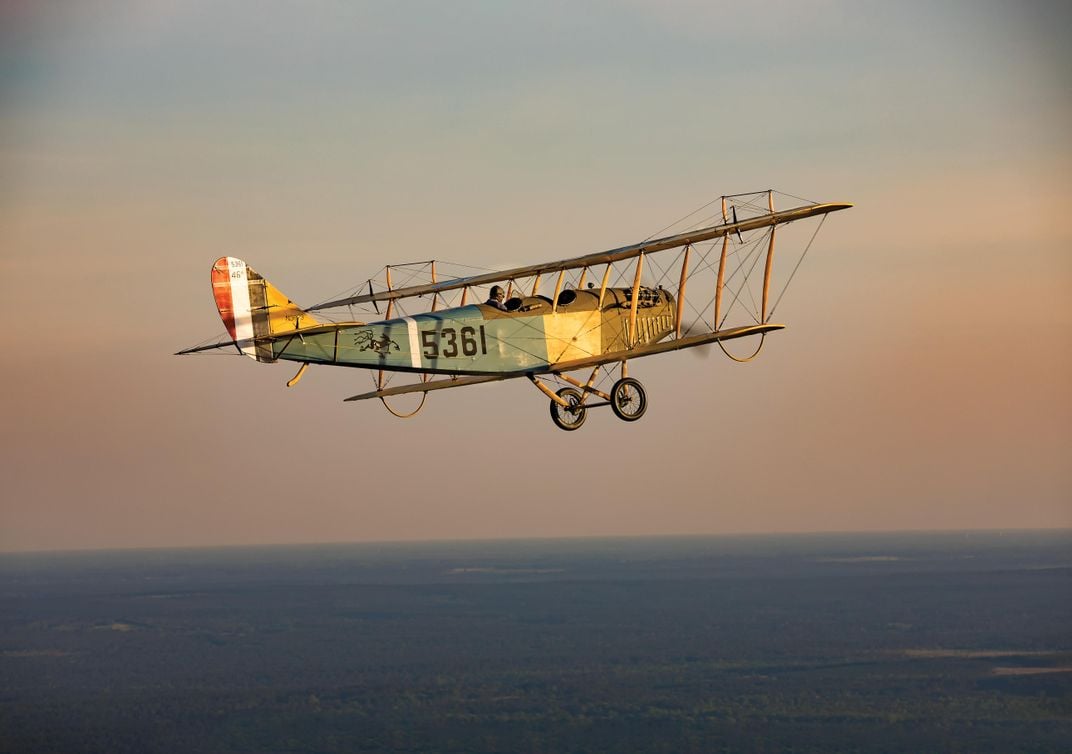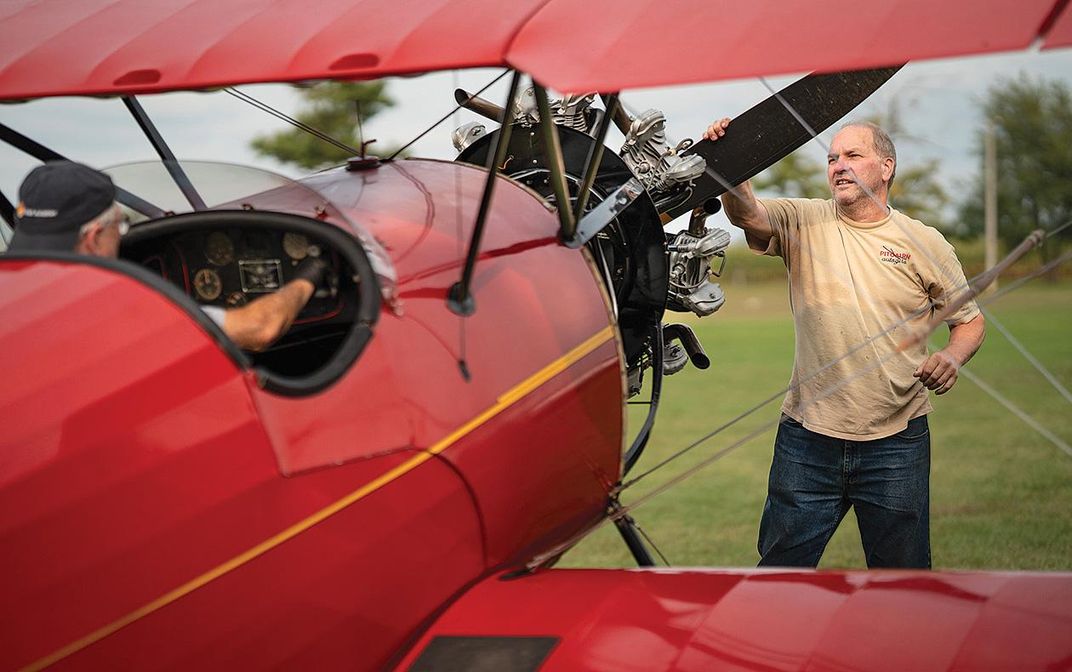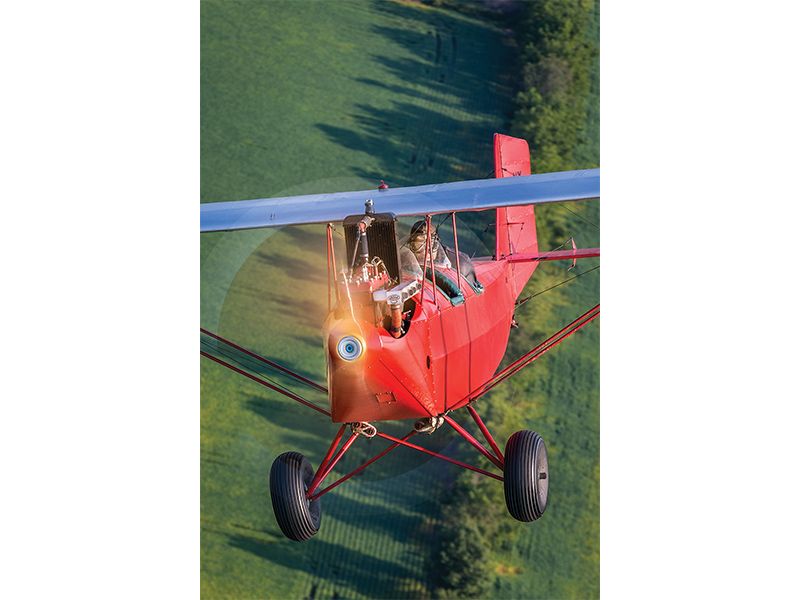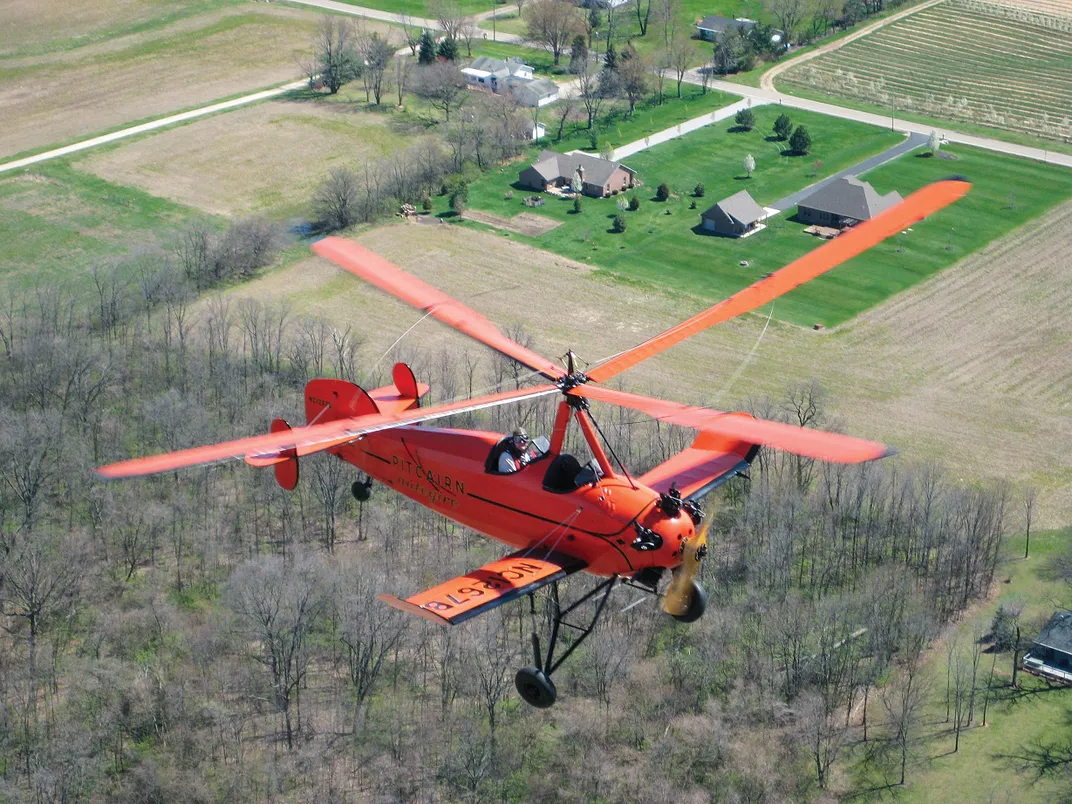The Barnstormer
It’s one of the oldest professions in aviation, and it requires more than flying skill.
/https://tf-cmsv2-smithsonianmag-media.s3.amazonaws.com/filer/aa/3e/aa3e34a5-3243-4c71-9af7-0722751332cc/07-2r_as2021_barnstormerandrewking__dsc5563_live.jpg)
At about 75 mph and 2,000 feet above the northern Virginia countryside, the purpose of an old, open-cockpit biplane is immediately obvious. You look down on newly plowed fields and old woods. The Rappahannock River rolls and unrolls beneath you. Much of the American Civil War was fought down there, armies churning up dust clouds or sinking in mud as they marched to and fro, maneuvering to cross the twisty river. Now you can see why rivers matter in war.
Earlier that morning at Culpeper Regional Airport, a small general‑aviation airport some 70 miles outside the metroplex of Washington, D.C., pilot Andrew King had laid out the flight plan. “I thought maybe we’d hop over to Shannon Airport in Fredericksburg for lunch,” he said. King is the owner and restorer of the bright-blue 1928 Travel Air biplane now swooping low over backyard swimming pools, metal barn roofs, and wetlands—glinting in the sunlight. Traffic is light on the interstate hauling commuters to and from the city. The Travel Air can barely keep up with the lane weavers and thundering 18-wheelers, but they are earthbound. You are not. When King obliges with a wing-over turn, you find yourself nearly screaming in delight, like a small child thrown into midair by a friendly giant. This is what old airplanes are for. They are for flying.

Sadly, Andrew King can’t fly you to lunch and back unless you’re a friend, a business client, or a visiting journalist, although he’d be delighted to take you and a companion as paying passengers on a short trip around Culpeper. The Federal Aviation Administration limits his commercial passenger business—Bald Eagle Biplane Rides—to a 25-mile radius from point of origin. These days, taking passengers for short rides in old biplanes is usually called “barnstorming,” although purists will tell you it is no such thing. Perhaps they’ll let you call it “ride hopping,” or maybe a (very) short charter flight. King just thinks of it as another chance to take someone flying, and he rarely passes up the chance.
If you move in antique airplane circles, you know of Andrew King. In the tight-knit community of aviators, collectors, and curators obsessed with the Golden Age—early 20th century aircraft from the Wright brothers to the start of World War II—King is an expert, and something of a celebrity. He has probably flown more varieties of Golden Age aircraft—125 pre-1950 types so far—than anyone else flying today. His latest addition was the 1930 Bird BK that Charles Lindbergh taught his wife to fly in.
Barnstorming is at the heart of the Golden Age appeal, possibly because the airplanes are so much fun to ride in. The practice is tangled up with real aviation history, dubious tall tales, nostalgia, and old movies such as The Great Waldo Pepper, but today’s barnstormers don’t necessarily engage in wing-walking, suicidal aerobatics, and wandering flying circuses. They sell rides. In addition to selling rides from his fixed base in northern Virginia, King has set up operations with barnstorming partner Dewey Davenport in Ohio. “Dewey and I just like giving rides and, of course, if people will pay you to take a ride, that’s even better. But you know, if I was independently wealthy, I might do it for free.”
Being far from independently wealthy, King makes his living restoring airplanes at his shop in Warrenton, Virginia. He also ferries other people’s antique airplanes around the country, and is a regular fixture at the Experimental Aircraft Association’s annual extravaganza in Oshkosh, Wisconsin, delivering obscure vintage aircraft that their owners prefer to arrive there unscratched. Getting to Oshkosh in one piece requires more than a GPS and a check book, especially for restored odd-duck aircraft that haven’t flown in decades. King’s process is to read whatever he can find of the aircraft’s original paperwork or first-hand flight reports, study drawings and specs, and seek out anyone who ever flew one or knew someone who flew one. In this role as historical test pilot, he has developed a reputation as an airplane whisperer.
That’s why Jim Hammond wanted no one else to deliver a 1932 Pitcairn PA-18 Autogiro to Oshkosh, where it won Reserve Grand Champion in 2009. The Autogiro, an early hybrid of an unpowered rotor copter and a small monoplane, was the masterwork of restorers Jack and Kate Tiffany of Spring Valley, Ohio, who worked for almost nine years to restore it. The type hadn’t been flown anywhere since the 1990s; the airplane, since the 1950s. Hammond, who was a financial supporter of the project, knew King from the One Dollar Pietenpol confederacy. King, Hammond, and other aficionados of Bernard Pietenpol’s 1930s build-your-own backyard flier, powered by a Ford Model A engine, restored the oldest example to flying condition in 1993. In 2000, they decided to rotate official ownership of the Pietenpol Air Camper among themselves for a nominal dollar. (King, the current “owner,” paid in pennies at the last transfer and claims to have overpaid by one cent.)
To prepare to fly the Autogiro, King interviewed the last two original Pitcairn pilots. The first was Stephen Pitcairn, son of the American manufacturer of the original rotorcraft. The second was Johnny Miller, the legendary barnstormer and test pilot who flew a Pitcairn PC-1 coast-to-coast in 1931. Miller was the real deal. In the late 1920s, he barnstormed up and down New York’s Hudson Valley in his Standard J-1 and New Standard D-24. But he deviated from the fly-by-night Waldo Pepper stereotype by earning a mechanical engineering degree from the Pratt Institute of Technology and a string of FAA qualifications and licenses, and by establishing his own full-service aviation shop at the Poughkeepsie airport, which he eventually managed. He lost interest in barnstorming in 1931 when he took delivery on his first Pitcairn Autogiro.
In 2007, when King went to see him in Poughkeepsie, Miller was 101 and had only surrendered his pilot’s license the year before. They talked about barnstorming and flying Autogiros. (Both Pitcairn and Miller died in 2008, shortly before the restored PA-18 was ready for testing.) The interviews were immensely helpful, King recalls, but flying the Autogiro raised questions that could only be answered the hard way—in the air. It was a unique flying experience, King recalls: “There was this crazy flapping stuff going on over your head, but once you got about 10 feet above the ground, everything was fine.” Once aloft, the unpowered rotor wing made the PA-18 virtually stall-proof. Once he got used to the incredibly short takeoff and steep landing approach, King was in love. “That was the only magic airplane I’ve ever flown,” he says.
Hammond was on hand with the whole restoration crew at the tiny Clark County, Ohio airport to witness the flight trials. The first three flights went beautifully. “Nobody was nervous,” Hammond says. “We’d all kind of learned along with Andrew about how everything was going to happen.” On the fourth flight, the engine quit. “It got real quiet,” says Hammond.
The watchers on the ground knew that the Autogiro landed in a peculiar stair-step fashion. “Instead of trying to glide it down to land, you could just pull the nose up and it’ll settle straight down and then you drop the nose a little bit and it’ll start moving forward,” says Hammond. “Andrew came in a little bit high over the end of the runway and he just pulled the nose up and let it sink, which is what it said in the book that it would do. And it did. It just sank straight down and then he dropped the nose again. And it went forward about 50 feet and he did a nice landing, like he’d been doing it forever.
“If this were a spot landing contest, he’d have nailed it,” says Hammond.
But what was King’s expression as he climbed out of the Autogiro after the dead stick landing? Was he ruffled? Hammond pauses for a moment before answering. “You know, I just can’t imagine Andrew being ruffled,” he says.
Flying antique airplanes is risky, but pilots like King don’t fly them for the adrenaline rush or even to indulge in nostalgia. They fly them to keep alive the knowledge of how to fly antique airplanes.
Andrew King caught that fever early in life. He practically grew up at the legendary Old Rhinebeck Aerodrome in the Hudson Valley. He was five in 1967 when his father got his pilot’s license, bought an old Piper Cub, and plunged his family into the antique aviation scene at Rhinebeck. Andrew, his uncle Dick, and his younger brother David were swept along. King can scarcely remember a time when he wasn’t washing airplanes, listening to hangar yarns, and running errands behind the scenes at Rhinebeck’s weekend Great War aerial melodramas. He soloed at 16 before he learned to drive. At 20, he joined the Rhinebeck rotating flying cast, sometimes piloting a replica of the fabled Red Baron’s Fokker Dr.1—a triplane that King considers the most difficult aircraft he’s ever flown. On the ground, you couldn’t see where you were going. In the air, you couldn’t relax a moment because of the Fokker’s hair-trigger instability. Still, he enjoyed his five seasons of Rhinebeck aerial theatrics and came away with the odd idea that antique aviation was a career path.
For his formal aviation education, King went to Parks Air College in St. Louis for two years to qualify as an FAA-certified aviation maintenance technician. But he also earned a bachelor’s degree in English from a small college in his hometown of Nyack, New York. Between English classes and Rhinebeck dogfights, he qualified for commercial and multi-engine commercial ratings.
After college, King took a series of jobs in restoration shops, aviation museums, and private collections. His time working on Kermit Weeks’ historic aircraft collection in Miami was cut short by Hurricane Andrew in 1992, which destroyed the Weeks hangars and King’s apartment. The Miami wipe-out sent him north to Ken Hyde’s The Wright Experience shop in Warrenton, Virginia, where Hyde was pursuing his ambitious plan to reproduce flying versions of all the early Wright brothers aircraft. The move brought King to rural Virginia. Dotted with private strips and small airports like Culpeper Regional, it was good country for old airplanes.
King has his hangars at Culpeper but keeps his restoration shop in Warrenton. Being off the airport grounds, you get more done without people wandering in to gawk and talk, he says. He lives in the greater Washington suburbs with his partner Julie Appleby. They share a passion for travel, but when they go on vacation, says King, they fly commercial. The shop work pays the bills, but more flying work—ferrying aircraft, hopping biplane rides, testing rebuilds—is what he craves.
Flying old airplanes has taken him to strange places. In 2003, he competed on the “Junkyard Wars” series—“my contribution to reality TV,” he says—as part of a team building a replica of a 1911 Walden IX monoplane, a spindly affair designed by dentist and inventor Henry Walden. The only unmarried team member, King was nominated as test pilot. The Walden IX came in last. In 2006, he was a movie stunt pilot, flying a replica Nieuport 17 in a big-budget World War I air war epic, Flyboys. But his most unexpected and longest running engagement was a private barnstorming fly-in that began with an unannounced landing on a family farm in eastern Indiana. The backstory is almost a fairy tale and the subject of a 2009 documentary, Barnstorming, directed by Bryan Reichhardt.
In 1999, King was flying in a flock of antique Pietenpols across Indiana on the return trip from Oshkosh. King has always loved flying over Midwestern farm country—so pretty, so flat, so many places to land. Near Winchester, Indiana, he spotted a photogenic alfalfa field and landed for a closer look. A second Pietenpol followed him down.
The field belonged to Matt Dirksen, who came running to help the seemingly distressed aircraft. King had a cover story ready—his Model A engine was overheating—but Dirksen’s friendliness was so disarming that King confessed they’d landed to take pictures. Dirksen was unfazed. Meantime his wife Paula and their children had come pouring out of the house to see what had dropped out of the sky. Soon the Dirksens were climbing aboard for short hops around the world’s prettiest alfalfa field.
Dirksen invited King and his flying friends back the following summer for a fly-in barbecue. For the next 19 years, the Dirksens invited neighbors, and King picked aviator friends heading for Oshkosh to stop with him for the free, one-day, fly-in barbecue. “I make it clear,” King says of his flier friends, “the only way you go is if I invite you.”
Even during the locked-down summer of 2020, King dropped by to give the youngest Dirksen daughter, Allie, her annual airplane ride.
Curious about King’s other barnstorming gigs, I met him at the Dewey Drome, the private airstrip and operations base for Dewey Davenport’s “Goodfolk & O’Tymes Biplane Rides” near Xenia, Ohio. Davenport’s day job is flying chartered business jets, but his dream is to do “real” barnstorming, traveling from county fairs to small-town airports in a big antique biplane, drumming up business with posters, low-level buzzes, and, this being the 21st century, a ton of social media. King and Davenport share the barnstorming dream, and the two have gone on short Midwestern tours in recent summers, that is, until summer 2020 disappeared. In April, King was at the Dewey Drome to plot the revival of the annual barnstorming carnival that Davenport had started in 2014 at the Springfield, Ohio municipal airport. Davenport says he is America’s only Black barnstormer working today. King agrees but points out there aren’t that many working barnstormers of any kind today.
We walked out to the Drome’s hangar to get a look at Davenport’s barnstorming pride and joy. It’s a New Standard D-25, an airplane with a big front cockpit that in 1930 could hold four. (It’s the same model that Johnny Miller flew in 1931.) In 2021, Americans come in larger sizes but the New Standard has significantly raised Davenport’s barnstorming capacity from the two-in-front 1929 Travel Air he started with.
Davenport figures that with himself working the credit card reader, a “scooter” handling passengers, and King flying the New Standard, they can easily hop 100 passengers a day at the Springfield Carnival—weather, virus, and customers permitting. We circled round the hangar, admiring the New Standard; the One Dollar Pietenpol, which is parked in back and ready in case the Pietenpol Fly-in at Brodhead, Wisconsin, restarts this summer; and Davenport’s orange and white Travel Air.
That brings us a month later to Virginia and my lunchtime ride in King’s pretty blue Travel Air. After lunch at Shannon Airport in Fredericksburg, we hopped back to Culpeper and pushed the airplane back into its hangar, popping the engine cowling to let it cool. Then we climbed into King’s old Honda to visit his backup hangar.
On the way, we talked about the future of antique aviation. King was not optimistic. It’s a generational thing, he says. At 59, he is actually at the back edge of the demographic that is fascinated by antiques. Although he’s cheered by younger pilot-entrepreneurs like Davenport, King sees less and less interest each year in pre-war airplanes, or for that matter pre-war cars, steam trains, and even World War II warbirds. “All of those things are old people’s games, and young people nowadays don’t care about steam trains or biplanes or that kind of thing,” he says. Resale values are dropping. He adds, “It’s definitely a one-way road.”
This belief leads to another thought, which sets King apart from many who are interested in historic aviation. His interest in old airplanes is in flying them. “That’s one of the things that irks me,” he says. “I often hear people say, ‘Oh, that’s a one-of-a-kind. It shouldn’t be flown any more. It’s too valuable. And we need to save it for future generations.’ I think future generations may not care a whit about this stuff. You put this in a museum, and 50 years from now nobody might come look at it. We might as well fly it now and take the risk. And if it crashes, oh well, but you know that people saw it fly and heard it make noise.”
I ask King why he enjoys giving 15-minute rides all day at an Ohio airfield or an Indiana alfalfa farm. “Oh, I don’t know,” he answers. “I mean, I like flying and I kind of like sharing it. It’s another reason for flying, I guess.”
At his Warrenton hangar sits yet another reason for flying: a 1954 gray Bücker Jungmann biplane with snappy blue trim that he’d recently bought and flown home from Kalispell, Montana. He says he had always wanted a Bücker, the best flier of all the pre-war trainers, designed for the German Luftwaffe. Restored in 1988, it has a 180-horsepower horizontal Lycoming instead of its original 150-horsepower in-line Tigre engine. In the update, it also gained disc brakes. But King points out that it still has most of its original fine touches, such as real leather crash padding around the cockpit. It also retains its superlative pre-1950 flying characteristics, he says. In the hangar where he keeps the Bücker, pushed in with his faithful 1939 Taylorcraft, is a replica British SE5 World War I fighter that he’s working on for a client, and an original World War I Rhone rotary radial on an engine test stand. He ran the Rhone a couple of weeks ago, he says. It must have been deafening.
But why did he buy the Bücker? It’s too small for barnstorming. He’s tall, and it takes him a few careful minutes to insert himself into the compact rear cockpit. It’s a trainer, but King doesn’t teach.
“As far as biplanes go, it’s about the top of the line for fun,” he says. “It’s really agile, but it’s pleasant to fly. Some of the fancy aerobatic airplanes are unstable because the more unstable they are, the more aerobatic they are. They are great fun because you can do so much, but they’re not pleasant. The Jungmann is agile enough so you can do loops and rolls and stuff, but it’s also pleasant to fly.”
He bought it because that’s what old airplanes are for. For fun. For flying.

/https://tf-cmsv2-smithsonianmag-media.s3.amazonaws.com/filer/3f/4b/3f4bafc1-daf1-41ee-88f8-04ee32adac49/07-2p_as2021_barnstormerandrewking_andrewking3_live.jpg)

/https://tf-cmsv2-smithsonianmag-media.s3.amazonaws.com/filer/c3/02/c3028d98-17fa-4e00-8ed1-7ac18e0ac02b/07-2g_as2021_barnstormerandrewking_gregmorehead_gm1_9375_live.jpg)

/https://tf-cmsv2-smithsonianmag-media.s3.amazonaws.com/filer/2a/23/2a23b868-9be9-4715-99a6-5e2aac507c23/07-2e_as2021_barnstormerandrewking_johnnymiller2791_live.jpg)
